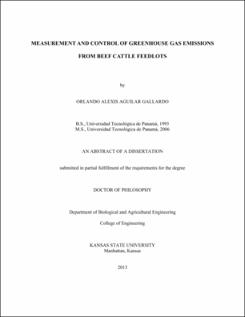| dc.contributor | Ronaldo Maghirang | |
| dc.contributor.author | Aguilar, Orlando | |
| dc.creator | Aguilar, Orlando | |
| dc.date.accessioned | 2018-07-13T17:05:47Z | |
| dc.date.available | 2018-07-13T17:05:47Z | |
| dc.date.issued | 2013-05-01 | |
| dc.identifier.uri | http://ridda2.utp.ac.pa/handle/123456789/5098 | |
| dc.description | Emission of greenhouse gases (GHGs), including nitrous oxide (N2O), methane (CH4), and carbon dioxide (CO2), from open beef cattle feedlots is becoming an environmental concern; however, scientific information on emissions and abatement measures for feedlots is limited. This research was conducted to quantify GHG emissions from feedlots and evaluate abatement measures for mitigating emissions. Specific objectives were to: (1) measure N2O emissions from the pens in a commercial cattle feedlot; (2) evaluate the effectiveness of surface amendments in mitigating GHG emissions from feedlot manure; (3) evaluate the effects of water application on GHG emissions from feedlot manure; and (4) compare the photo-acoustic infrared multi-gas analyzer (PIMA) and gas chromatograph (GC) in measuring concentrations of N2O and CO2 emitted from feedlot manure.
Field measurements on a commercial beef cattle feedlot using static flux chambers combined with GC indicated that N2O emission fluxes varied significantly with pen surface condition. The moist/muddy surface had the largest median emission flux; the dry and compacted, dry and loose, and flooded surfaces had significantly lower median emission fluxes.
Pen surface amendments (i.e., organic residues, biochar, and activated carbon) were applied on feedlot manure samples in glass containers and evaluated for their effectiveness in mitigating GHG emissions. Emission fluxes were measured with the PIMA. For dry manure, all amendments showed significant reduction in N2O and CO2 emission fluxes compared with the control (i.e., no amendment). For moist manure, biochar significantly reduced GHG emissions at days 10 and 15 after application; the other amendments had limited effects on GHG emissions.
The effect of water application on GHG emissions from feedlot manure was evaluated. Manure samples (with and without water application) were placed in glass containers and analyzed for GHG emission using a PIMA. For the dry manure, GHG emissions were negligible. Application of water on the manure samples resulted in short-term peaks of GHG emissions a few minutes after water application.
Comparison of the GC and PIMA showed that they were significantly correlated but differed in measured concentrations of N2O and CO2. The PIMA showed generally lower N2O concentrations and higher CO2 concentrations than the GC. | en_US |
| dc.description.abstract | Emission of greenhouse gases (GHGs), including nitrous oxide (N2O), methane (CH4), and carbon dioxide (CO2), from open beef cattle feedlots is becoming an environmental concern; however, scientific information on emissions and abatement measures for feedlots is limited. This research was conducted to quantify GHG emissions from feedlots and evaluate abatement measures for mitigating emissions. Specific objectives were to: (1) measure N2O emissions from the pens in a commercial cattle feedlot; (2) evaluate the effectiveness of surface amendments in mitigating GHG emissions from feedlot manure; (3) evaluate the effects of water application on GHG emissions from feedlot manure; and (4) compare the photo-acoustic infrared multi-gas analyzer (PIMA) and gas chromatograph (GC) in measuring concentrations of N2O and CO2 emitted from feedlot manure.
Field measurements on a commercial beef cattle feedlot using static flux chambers combined with GC indicated that N2O emission fluxes varied significantly with pen surface condition. The moist/muddy surface had the largest median emission flux; the dry and compacted, dry and loose, and flooded surfaces had significantly lower median emission fluxes.
Pen surface amendments (i.e., organic residues, biochar, and activated carbon) were applied on feedlot manure samples in glass containers and evaluated for their effectiveness in mitigating GHG emissions. Emission fluxes were measured with the PIMA. For dry manure, all amendments showed significant reduction in N2O and CO2 emission fluxes compared with the control (i.e., no amendment). For moist manure, biochar significantly reduced GHG emissions at days 10 and 15 after application; the other amendments had limited effects on GHG emissions.
The effect of water application on GHG emissions from feedlot manure was evaluated. Manure samples (with and without water application) were placed in glass containers and analyzed for GHG emission using a PIMA. For the dry manure, GHG emissions were negligible. Application of water on the manure samples resulted in short-term peaks of GHG emissions a few minutes after water application.
Comparison of the GC and PIMA showed that they were significantly correlated but differed in measured concentrations of N2O and CO2. The PIMA showed generally lower N2O concentrations and higher CO2 concentrations than the GC. | en_US |
| dc.format | application/pdf | |
| dc.language.iso | eng | en_US |
| dc.rights | info:eu-repo/semantics/openAccess | |
| dc.rights | https://creativecommons.org/licenses/by-nc-sa/4.0/ | |
| dc.subject | Photo-acoustic infrared multigas analyzer | en_US |
| dc.subject | Biochar and activated carbon | en_US |
| dc.subject | Static flux chambers | en_US |
| dc.subject | Feedlot GHG emissions | en_US |
| dc.subject | Greenhouse gases | en_US |
| dc.subject | Surface amendments | en_US |
| dc.title | Measurement and control of greenhouse gas emissions from beef cattle feedlots | en_US |
| dc.type | info:eu-repo/semantics/doctoralThesis | |
| dc.type | info:eu-repo/semantics/publishedVersion | |
| thesis.contributor.director | Ronaldo Maghirang | |
| thesis.university | Kansas State University | |
| thesis.country | EE. UU. | |
| thesis.degree.grantor | Doctor of Philosophy | |
| thesis.subtype | Tesis Doctorado | |
| thesis.language | English | |
